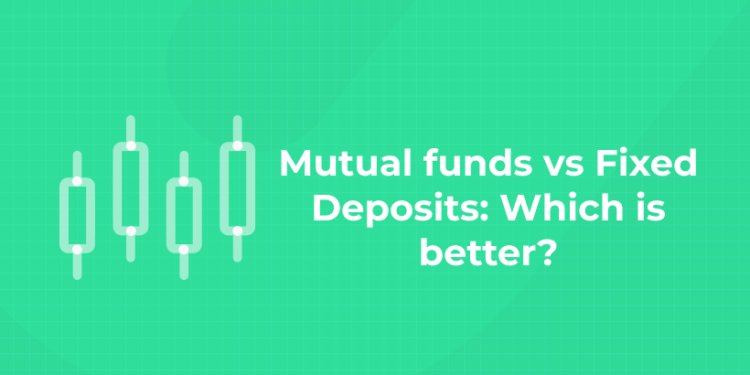Table of Contents
Imagine this: You just got a fat bonus from your job and wondering how to make it grow. Your uncle swears by fixed deposits (FDs), telling tales of guaranteed returns over a cup of chai. Meanwhile your colleague can’t stop raving about mutual funds, claiming they’ve turned her small savings into a fortune. Suddenly you’re in a tug-of-war between two giants—mutual funds vs fixed deposits. Which one’s the winner for you?
In India where every rupee matters—whether it’s for a child’s education, a dream home or a comfortable retirement—this is not a casual choice; it’s a life defining decision. The Indian stock market is buzzing, Sensex is climbing and investment options are more accessible than ever. But with great options come great debates. Should you lock your money in the steady comfort of an FD or ride the thrill of mutual funds? This is not just a comparison; it’s a showdown. Stick with me as we break down what these two are, how they differ and which one can change your financial future. Ready to find out? Let’s get started!
Introduction
Money doesn’t grow on trees but it can grow if you plant it in the right soil. For decades Indians have been wrestling with where to put their hard earned money. Fixed deposits have been the go to, a trusted friend offering predictability in a chaotic world. Meanwhile mutual funds have stormed into the scene promising higher returns and a taste of the stock market’s magic. Both have fans but they couldn’t be more different—one’s a tortoise the other a hare.
In 2025 with India’s economy booming and Sensex soaring past 80,000 the stakes are higher than ever. Inflation is nibbling at your savings and the old trick of stuffing cash under the mattress won’t cut it anymore. So how do you choose? Do you play it safe with an FD’s guaranteed returns or take a calculated risk with mutual funds’ growth potential? This blog isn’t just about facts; it’s about helping you decide what’s right for you. From returns to risks we’ll dissect these two heavyweights and crown a winner. Interested yet? Let’s start with the basics.
Ready to take your Trading skills to the next level? Sign up for a free demo today!
What is a Mutual Fund?
1: What is a stock?
Imagine pooling your money with thousands of others and handing it to a financial magician who spreads it across stocks, bonds and more to make it grow. That’s a mutual fund in a sentence. It’s like a diversified thali—some equity, some debt, maybe a pinch of gold—served by experts who know the Indian market like the back of their hand.
In India, mutual funds have gone crazy. By 2024, the Assets Under Management (AUM) touched ₹50 lakh crore, as per the Association of Mutual Funds in India (AMFI). Why? Because they’re flexible and accessible. You can start a Systematic Investment Plan (SIP) with just ₹500 a month—less than a weekend movie ticket—and watch your money grow over time. Whether it’s equity funds riding the Nifty 50’s highs or debt funds offering stability, there’s a flavor for everyone.
Take Priya, a 30-year-old teacher I met at a financial literacy camp. She started a ₹2,000 monthly SIP in an equity mutual fund 5 years ago. Today, her ₹1.2 lakhs investment is worth ₹2 lakhs, thanks to 12% annualized returns. That’s the power of mutual funds—they leverages the stock market’s ups (and sometimes downs) to create wealth. But here’s the catch: returns aren’t guaranteed and the ride can get bumpy. Is it worth it? Hold that thought—we’ll come back to that.
What is a Fixed Deposit?
Now, meet the grandfather of Indian investments: the fixed deposit. It’s as simple as it gets—give your money to a bank or post office, lock it away for a set period (say, 1 to 5 years) and earn a fixed interest rate. No surprises, no rollercoasters—just a steady stream of returns. In India, FDs have been a household name, from small-town post offices to big-city banks offering rates between 5-7% in 2025.
Why do people love FDs? Safety. Your principal is protected and the interest is locked in—rain or shine, Sensex crash or boom. If you invest ₹5 lakhs at 6% for 5 years, you’ll get ₹6.69 lakhs, no questions asked. It’s the financial equivalent of a warm blanket on a rainy night. My neighbour, Mr. Sharma, swears by FDs. He’s parked ₹10 lakhs in a bank FD, earning ₹65,000 yearly—enough to pay his grandson’s school fees without breaking a sweat.But here’s the catch: those returns don’t keep pace with inflation, which is 5-6% in India. Over time, your money’s buying power reduces. Comfortable? Yes. Exciting? Not quite. So, how do these two stack up head-to-head? Let’s see.
Mutual Funds vs Fixed Deposits: Key Differences
Mutual funds and fixed deposits are like chalk and cheese—both have their fun, but they serve different appetites. Let’s break it down:
- Risk: FDs are safe—your money’s safe unless the bank collapses (and with RBI-backed deposit insurance up to ₹5 lakhs, even that’s rare). Mutual funds? They dance to the market’s beat. Equity funds can go up with Nifty but down during a downturn. Debt funds are steadier but still carry some risk.
- Returns: FDs offer fixed interest—5-7% today. Mutual funds aim higher—equity funds average 10-15% over the long term, per historical data from the Indian stock market, while debt funds clock 6-8%.
- Liquidity: Need cash fast? FDs lock your money (break it early and you’ll pay a penalty). Mutual funds are more flexible—sell your units anytime (though equity funds are best with patience).
- Investment Amount: FDs need a lump sum (₹5,000 minimum, say). Mutual funds welcome small bites—start an SIP with ₹500 monthly.
- Taxation: FD interest is fully taxable as per your slab (up to 30% for high earners). Mutual fund gains? Equity funds held over a year get a 10% long-term capital gains tax (above ₹1 lakh), while ELSS funds offer Section 80C deductions.
Here’s the hook: FDs are the safe harbor, but mutual funds are the wind in your sails. One keeps you grounded; the other pushes you forward. Which matters more to you—security or growth? Let’s dive into returns to find out.
Returns: Which Offers Better Growth?
Returns are the heart of this battle, so let’s get to it. Say you invest ₹1 lakh today. In an FD at 6% for 5 years, you’d get ₹1.33 lakhs—safe, steady, but modest. Now, park that same ₹1 lakh in an equity mutual fund averaging 12% annually (a realistic figure based on India’s market history). After 5 years? ₹1.76 lakhs. Stretch it to 10 years, and it’s ₹3.1 lakhs, while the FD limps to ₹1.79 lakhs. That’s the magic of compounding in mutual funds—time turns small seeds into big trees.
But wait—FDs aren’t out yet. Inflation’s the silent thief. At 5% yearly, your ₹1.33 lakhs from the FD buys less in 5 years than ₹1 lakh does today. Mutual funds, even with market dips, have historically outrun inflation. Look at the Nifty 50—despite crashes like 2008 or 2020, it’s delivered 12-14% annualized returns over decades. Funds like SBI Bluechip or Mirae Asset Large Cap are inflation-beaters.Here’s a real story: My cousin invested ₹2 lakhs in an FD in 2015 at 7%. By 2020, she had ₹2.8 lakhs—nice, but her dream car still slipped away as prices soared. Her friend chose a mutual fund SIP instead—₹5,000 monthly for 5 years (₹3 lakhs total). By 2020, it was worth ₹4.5 lakhs. She bought the car and had change. Returns don’t lie—mutual funds flex harder. But is higher always better? Let’s find out.
Stock Market Training Reviewed & Monitored by SEBI Registered RA
Trusted, concepts to help you grow with confidence. Enroll now and learn to start investing the right way.
Know moreWhich One Should You Choose?
This isn’t a one-size-fits-all answer—it’s about you. Are you the cautious type, sleeping better knowing your money’s untouchable? Fixed deposits are your match. They’re perfect for short-term goals—like saving for a wedding in two years—or for retirees who can’t stomach market swings. If you’ve got ₹5 lakhs and need ₹5.5 lakhs guaranteed, FDs deliver.
But if you’re dreaming bigger—say, a kid’s MBA in 10 years or a comfy retirement—mutual funds beckon. They’re for the bold, the patient, the ones who see money as a tool to multiply, not just preserve. Start an SIP in an equity fund, ride out the market’s waves and watch your wealth bloom. Even debt mutual funds beat FDs for short-term goals, offer 6-8% with more flexibility.
Here’s the persuasive twist: why settle for less when you can have more? India’s financial landscape is changing—mutual fund SIP accounts hit 9 crore in 2024 (AMFI data), while FD growth slows. Young professionals, homemakers, even small-town earners are jumping in. Why? Because 6% won’t cut it when inflation’s at 5% and your dreams cost 10% more every year. Mutual funds aren’t reckless—they’re strategic. Diversify with a hybrid fund, ease in with a debt fund or go big with equity. You’re not gambling; you’re growing.
Still confused? Blend them. Put 60% in mutual funds for growth, 40% in FDs for safety. It’s not about picking a side—it’s about picking what works. So, what’s your move?
Conclusion
Mutual funds vs fixed deposits isn’t just a debate—it’s a mirror to your goals. FDs offer the comfort of certainty, a financial rock in turbulent times. Mutual funds promise the thrill of growth, tapping into India’s roaring stock market to create real wealth. One’s a safety net; the other’s a ladder.
In 2025, with the Sensex climbing and inflation lurking, standing still isn’t an option. FDs might keep you afloat, but mutual funds can lift you higher. It’s not about right or wrong—it’s about now or later, safety or ambition. Open a Demat account, start an SIP or lock in an FD today. Your money’s waiting to work—make it work for you. Which path will you take? The clock’s ticking—decide now.
Stock Market Training Reviewed & Monitored by SEBI Registered RA
Trusted, concepts to help you grow with confidence. Enroll now and learn to start investing the right way.
Know moreFrequently Asked Questions
What’s the main difference between mutual funds and fixed deposits in India?
Fixed deposits (FDs) offer guaranteed returns with low risk, while mutual funds aim for higher growth but carry market risks—safety vs. potential.
Which should a beginner in India choose—mutual funds or FDs?
FDs suit risk-averse beginners craving certainty. Mutual funds (via SIPs) are better for learning, growing, and beating inflation over time.
Are fixed deposits safer than mutual funds?
Yes, FDs are backed by banks and insured up to ₹5 lakhs by the RBI, while mutual funds fluctuate with the market—no guarantees.
Which gives better returns—mutual funds or fixed deposits?
Mutual funds, especially equity ones, average 10-15% annually long-term, beating FD rates of 5-7%. Growth comes with patience, though.
Can I start investing in mutual funds with a small amount?
Absolutely! SIPs start at ₹500 monthly—less than a meal out—making mutual funds accessible, unlike FDs that often need lump sums.
How does inflation affect fixed deposits and mutual funds?
Inflation (5-6%) erodes FD returns (5-7%), shrinking real value. Mutual funds (10-15%) historically outpace it, preserving and growing purchasing power.
Are mutual fund returns guaranteed like fixed deposits?
No, mutual funds depend on market performance—equity funds can soar or dip, unlike FDs’ fixed, predictable interest. Risk equals reward potential.
Which is better for short-term goals in India?
FDs win for short-term (1-3 years)—guaranteed returns with no surprises. Debt mutual funds are a close second with slightly higher gains.
How do taxes work for mutual funds vs fixed deposits?
FD interest is taxed per your slab (up to 30%). Equity mutual fund gains over ₹1 lakh (held 1+ year) face 10% LTCG tax.
Can I withdraw money easily from both options?
FDs lock your cash—early withdrawal cuts interest. Mutual funds offer liquidity—sell units anytime, though equity funds reward longer holds.












